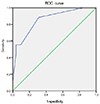Abstract
Purpose
To investigate the factors that improve the success rate in patients with recurrent exotropia.
Methods
A total of 60 patients who had undergone reoperation for recurrent exotropia and had at least 1 year of follow-up after surgery were included in this study. In total, 43 patients in the group with one-muscle surgery had undergone either unilateral medial rectus resection or unilateral lateral rectus recession, and the other 17 patients in the group with two-muscle surgery had undergone either bilateral medial rectus resection or lateral rectus muscle recession with medial rectus muscle resection of contralateral eye. The main outcome measure was final success rate, which was compared between the 2 groups.
Results
In this study, 41 (95.3%) of 43 patients in the group with one-muscle surgery had successful outcomes, while 2 (4.7%) had undercorrection at the final follow-up examination. On the other hand, 10 (58.8%) of 17 patients in the group with two-muscle surgery had successful outcomes, 5 (29.4%) had undercorrection, and 2 (11.8%) had overcorrection. The success rates were significantly different between the 2 groups (p = 0.001). In addition, preoperative deviation had the largest area under the receiver operator characteristic (ROC) curve for the success rate and exhibited an optimal balance of both sensitivity and specificity using a cut-off value of 25 PD.
Figures and Tables
 | Figure 1Diagram of study patients. The group with one-muscle surgery and the group with two-muscle surgery. BLR = bilateral lateral rectus muscle; UMR = unilateral medial rectus muscle; BMR = bilateral medial rectus muscle; R&R = lateral rectus muscle recession and medial rectus muscle resection; ULR = unilateral lateral rectus muscle. |
 | Figure 2Receiver operator characteristic (ROC) graph showing the sensitivity and specificity of the various prism diopters. Preoperative deviation had the largest area under the ROC curve (0.855) for the success rates and exhibited an optimal balance of both sensitivity and specificity using a cut-off value of 24.5 PD (see Table 6). |
Table 1
Surgical dose table for patients with recurrent exotropia after 1st operation in the group with one-muscle surgery and the group with two-muscle surgery

Table 3
Final success rates for the group with one-muscle surgery and the group with two-muscle surgery

References
1. Oh JY, Hwang JM. Survival analysis of 365 patients with exotropia after surgery. Eye (Lond). 2006; 20:1268–1272.
2. Richard JM, Parks MM. Intermittent exotropia. Surgical results in different age groups. Ophthalmology. 1983; 90:1172–1177.
3. Pratt-Johnson JA, Barlow JM, Tillson G. Early surgery in intermittent exotropia. Am J Ophthalmol. 1977; 84:689–694.
4. Ekdawi NS, Nusz KJ, Diehl NN, Mohney BG. Postoperative outcomes in children with intermittent exotropia from a population-based cohort. J AAPOS. 2009; 13:4–7.
5. Olitsky SE, Kelley CJ, Lee H, Nelson LB. Unilateral rectus resection in the treatment of undercorrected or recurrent strabismus. J Pediatr Ophthalmol Strabismus. 2001; 38:349–353.
6. Cho WK, Lee SY, Lee YC. The effect of medial rectus resection in reccurent exotropia after lateral rectus recession. J Korean Ophthalmol Soc. 2009; 50:1093–1097.
7. Suh YW, Seo IH, Cho YA, Kim SH. Analysis of the effects of medial rectus muscle resection for recurrent exotropia. Korean J Ophthalmol. 2011; 25:341–343.
8. Yoo EJ, Kim SH. Optimal surgical timing in infantile exotropia. Can J Ophthalmol. 2014; 49:358–362.
9. Chae SH, Chun BY, Kwon JY. The effect of unilateral medial rectus muscle resection in patients with recurrent exotropia. Korean J Ophthalmol. 2008; 22:174–177.
10. Kim SC, Kim MM. The efficacy of unilateral rectus resection in the reoperation of strabismus. J Korean Ophthalmol Soc. 2003; 44:904–910.
11. Yang HK, Hwang JM. Bilateral vs unilateral medial rectus resection for recurrent exotropia after bilateral lateral rectus recession. Am J Ophthalmol. 2009; 148:459–465.
12. Park HY, Yoo MH, Choi DG. Comparison of surgical results between unilateral recession-resection and bilateral resections in recurrent exotropia. J Korean Ophthalmol Soc. 2006; 47:148–153.
13. Chung YK, Lee SY, Lee YC. Dose-effect relationship of unilateral medial rectus resection for recurrent exotropia. J Korean Ophthalmol Soc. 2015; 56:420–426.
14. Cho YA, Kim SH. Role of the equator in the early overcorrection of intermittent exotropia. J Pediatr Ophthalmol Strabismus. 2009; 46:30–34.




 PDF
PDF ePub
ePub Citation
Citation Print
Print







 XML Download
XML Download